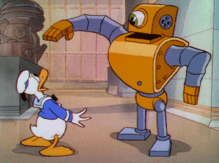Modern Inventions
Modern Inventions is a 1937 American animated short film produced by Walt Disney Productions and released by United Artists.[3] The cartoon follows Donald Duck as he tours the fictional Museum of Modern Marvels. It was directed by Jack King, his first project at the Disney studio, and features original music by Oliver Wallace. The voice cast includes Clarence Nash as Donald, Billy Bletcher as the Robot Butler, Adriana Caselotti as the Robot Baby Carriage and Cliff Edwards (in one of his first Disney roles) as the Robot Barber.[4]
| Modern Inventions | |
|---|---|
 "Your hat, sir." | |
| Directed by | Jack King |
| Produced by | Walt Disney |
| Story by | Carl Barks |
| Starring | Clarence Nash Billy Bletcher Adriana Caselotti Cliff Edwards |
| Music by | Oliver Wallace |
| Animation by | Jack Hannah Paul Allen Johnny Cannon[1] |
| Color process | Technicolor |
Production company | |
| Distributed by | United Artists |
Release date |
|
Running time | 8 minutes 30 seconds |
| Country | United States |
| Language | English |
Modern Inventions pokes fun at modern conveniences. The scene of Donald in the barber's chair was submitted by Carl Barks as his first story contribution at Disney.[5] It is also the final Disney short to be released by United Artists.
Plot
Donald visits the "Museum of Modern Marvels" which showcases various futuristic electronic appliances and inventions. He uses a quarter on a line to get in (this allows him to keep his money and get in as well). Once inside, he is confronted with the "Robot Butler", a robotic golden cyclops who takes hats ("Your hat, sir.") After Donald's hat is taken away from him, Donald uses a magic trick to produce another hat (similar to the way he produces flutes in The Band Concert). He says, "So!" and continues on his way. He first encounters a robotic hitch-hiker, which activates when he makes driving noises. However, when he laughs at it, it punches him in the face. Next he goes to the wrapping machine, which says "Do not touch" but Donald ignores the sign and hops on. When he pulls a lever, the machine proceeds to grab him in two robotic arms, put transparent wrapping paper around him, and put him in ribbons, like a package. He manages to break out by vigorously shaking, and continues exploring.
All the time, Donald has been losing hat after hat to the Robot Butler, making Donald angrier and angrier. Eventually, the Butler chases him through the museum to an automated baby carriage, which Donald hides inside. Donald is given a baby's hat to wear as is rocked as the song "Rock-a-bye Baby" is played. Donald then begins acting like a baby, sucking his feet, playing with toys offered to him and getting ticked under the chin, and having his feet counted "This Little Piggy went to market." Donald then begins whining about not getting his milk. The machine gets out a bottle of milk but it hits him in the face instead of going into his mouth, making Donald agitated. The machine begins torturing him with toys and more milk in the face, turning him over and pinning a diaper on his bottom and powdering it.
The Robot Butler is again attracted by Donald's laughing and yanks the baby hat off his head. Donald produces one last hat and goes to the one exhibit he's not yet seen: a self-operating hair makeup chair. Using his "cheat" coin, Donald pays to get his hair done. However, instead of giving him a haircut, it flips him over, removes his hat, and given his bottom a cut, wrapping his rear end in a towel, cutting off his tail feathers, cleaning his bill, coating his face with shoe polish, sifting through his bottom feathers, applying a wet towel to it, slapping his blackened face with a cloth, combing his bottom with a comb, making a gap through it, smoothing it out and finally, giving him a pig tail design. The Robot Butler appears and removes Donald's last hat, which causes Donald to enter an explosive rage.
Voices
Uncredited
- Clarence Nash – Donald Duck
- Billy Bletcher – Robot Butler
- Adriana Caselotti — Robot Baby Carriage
- Cliff Edwards – Robot Barber Chair
Releases[6]
- May 29, 1937 – original release (theatrical)
- 1985 – "Cartoon Classics: The Continuing Adventures of Chip 'n' Dale Featuring Donald Duck" (VHS)
- c. 1992 – Mickey's Mouse Tracks, Episode 7 (TV)
- c. 1992 – Donald's Quack Attack, Episode 30 (TV)
- December 24, 1997 – Ink & Paint Club, Episode 26 "Classic Donald" (TV)[7]
- May 18, 2004 – "The Chronological Donald Volume One" (DVD)
Legacy
- The cartoon would later serve as inspiration for suicide booths, fictional contraptions appearing in the American adult animated sitcom Futurama.
See also
References
- Modern Inventions Archived March 17, 2011, at the Wayback Machine at The Encyclopedia of Disney Animated Shorts
- Kaufman, J.B.; Gerstein, David (2018). Walt Disney's Mickey Mouse: The Ultimate History. Cologne: Taschen. ISBN 978-3-8365-5284-4.
- Lenburg, Jeff (1999). The Encyclopedia of Animated Cartoons. Checkmark Books. pp. 74–76. ISBN 0-8160-3831-7. Retrieved June 6, 2020.
- Hischak, Thomas S. (2011). Disney Voice Actors: A Biographical Dictionary. McFarland & Company. p. 257. ISBN 978-0786462711. Retrieved February 15, 2020.
- Trivia from Modern Inventions at the Internet Movie Database.
- Modern Inventions Archived March 17, 2011, at the Wayback Machine at The Encyclopedia of Disney Animated Shorts
- Movie connections for "Ink & Paint Club" at the Internet Movie Database